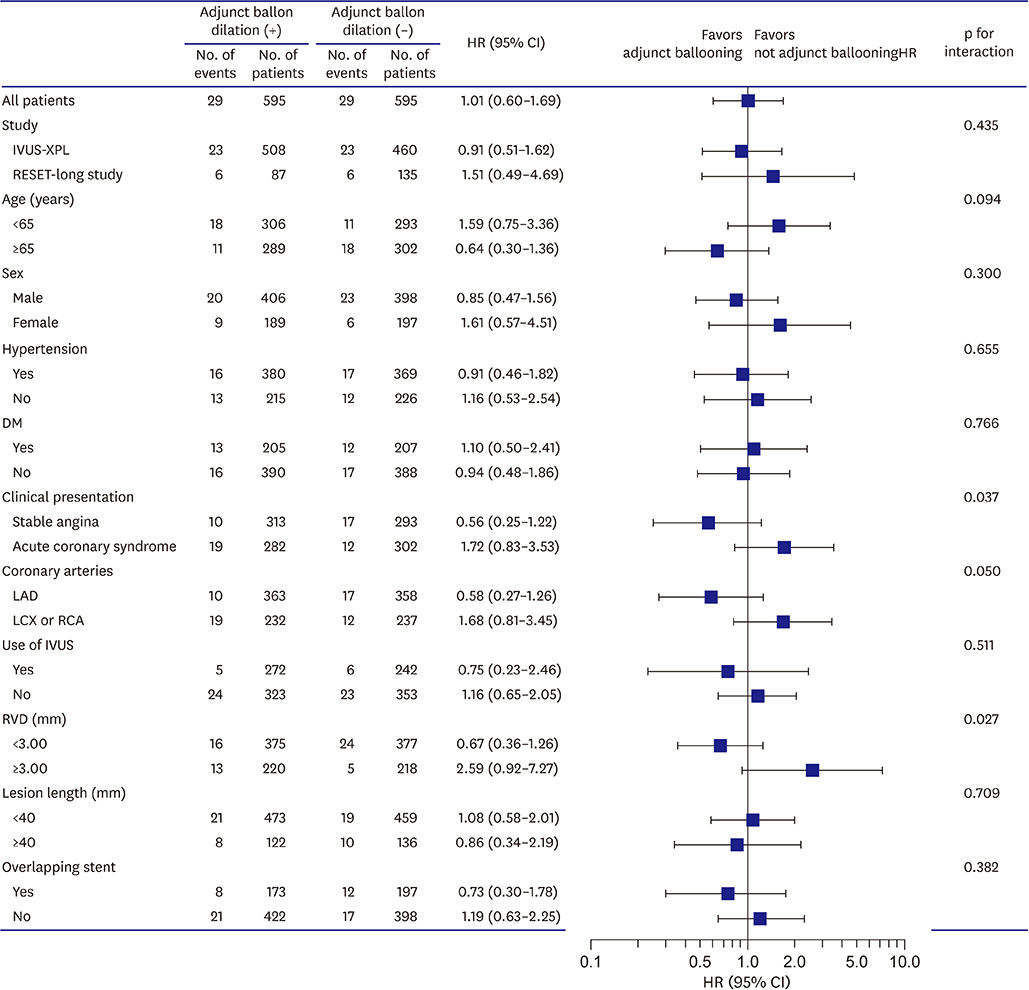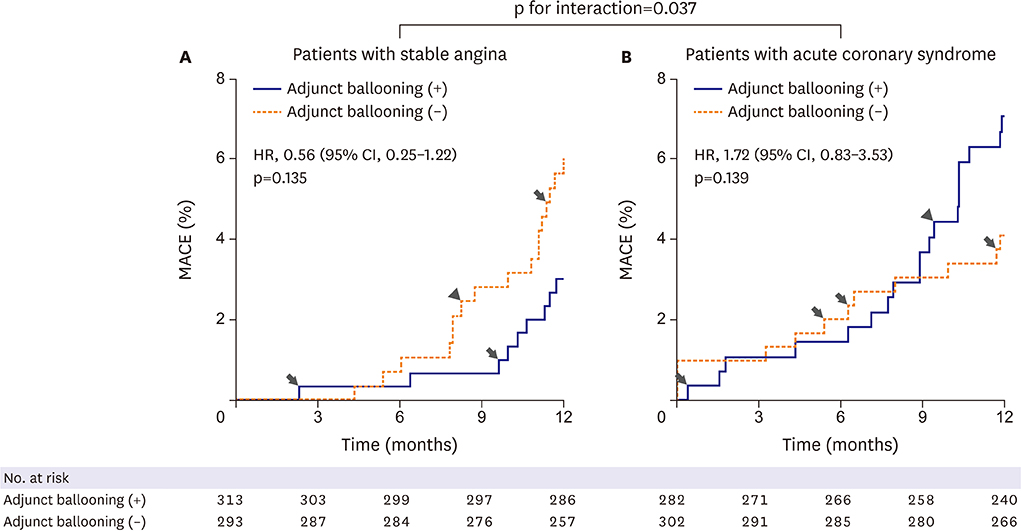Korean Circ J.
2017 Sep;47(5):694-704. 10.4070/kcj.2017.0016.
Effect of Adjunct Balloon Dilation after Long Everolimus-eluting Stent Deployment on Major Adverse Cardiac Events
- Affiliations
-
- 1Division of Cardiology, Severance Cardiovascular Hospital, Yonsei University Health System, Seoul, Korea. mkhong61@yuhs.ac
- 2Department of Internal Medicine, Kangwon National University School of Medicine, Chuncheon, Korea.
- 3Severance Biomedical Science Institute, Yonsei University College of Medicine, Seoul, Korea.
- 4Cardiovascular Research Institute, Yonsei University College of Medicine, Seoul, Korea.
- KMID: 2389602
- DOI: http://doi.org/10.4070/kcj.2017.0016
Abstract
- BACKGROUND AND OBJECTIVES
The effectiveness of adjunct balloon dilation after drug-eluting stent (DES) deployment has not been sufficiently evaluated. We evaluated whether adjunct balloon dilation was associated with a reduction in major adverse cardiac events (MACEs) after long everolimus-eluting stents (EESs) implantation.
SUBJECTS AND METHODS
Drawing from 2 randomized trials, a total of 1,672 patients treated with long EES were analyzed. Of 1,672 patients, 1,061 patients (64%) received post-stent adjunct balloon dilation. MACE, defined as a composite of cardiac death, myocardial infarction, and target-lesion revascularization (TLR), was compared between patients who received post-stent adjunct balloon dilation and patients who did not in 595 propensity score-matched pairs.
RESULTS
For the matched population, MACE occurred in 29 patients (4.9%) who received adjunct balloon dilation and in 29 patients (4.9%) who did not (hazard ratio [HR], 1.01; 95% confidence interval [CI], 0.60-1.69; p=0.972). However, significant interactions were observed among the subgroups for clinical presentation and vessel size. Adjunct balloon dilation was more favored within the subset of patients with stable angina vs. the subset of patients with acute coronary syndrome (p for interaction=0.037), and within the subset of lesions with small vessel diameter (reference vessel diameter [RVD] <3 mm) vs. the subset of lesions with larger vessel diameter (RVD ≥3 mm; p for interaction=0.027).
CONCLUSION
Adjunct balloon dilation was not associated with MACE reduction at 1 year among patients requiring long EES implantation. However, post-stent adjunct balloon dilation may be necessary for patients requiring long EES implantation who present with stable angina or for lesions with small vessel diameters.
MeSH Terms
Figure
Reference
-
1. Brodie BR, Cooper C, Jones M, Fitzgerald P, Cummins F; Postdilatation Clinical Compartative Study (POSTIT) Investigators. Is adjunctive balloon postdilatation necessary after coronary stent deployment? Final results from the POSTIT trial. Catheter Cardiovasc Interv. 2003; 59:184–192.2. Russo RJ, Silva PD, Teirstein PS, et al. A randomized controlled trial of angiography versus intravascular ultrasound-directed bare-metal coronary stent placement (the AVID Trial). Circ Cardiovasc Interv. 2009; 2:113–123.3. Hur SH, Kitamura K, Morino Y, et al. Efficacy of postdeployment balloon dilatation for current generation stents as assessed by intravascular ultrasound. Am J Cardiol. 2001; 88:1114–1119.4. Romagnoli E, Sangiorgi GM, Cosgrave J, Guillet E, Colombo A. Drug-eluting stenting: the case for post-dilation. JACC Cardiovasc Interv. 2008; 1:22–31.5. Hoffmann R, Guagliumi G, Musumeci G, et al. Vascular response to sirolimus-eluting stents delivered with a nonaggressive implantation technique: comparison of intravascular ultrasound results from the multicenter, randomized E-SIRIUS, and SIRIUS trials. Catheter Cardiovasc Interv. 2005; 66:499–506.6. Iakovou I, Mintz GS, Dangas G, et al. Increased CK-MB release is a “trade-off” for optimal stent implantation: an intravascular ultrasound study. J Am Coll Cardiol. 2003; 42:1900–1905.7. Pasceri V, Pelliccia F, Pristipino C, et al. Clinical effects of routine postdilatation of drug-eluting stents. Catheter Cardiovasc Interv. 2014; 83:898–904.8. Fröbert O, Sarno G, James SK, Saleh N, Lagerqvist B. Effect of stent inflation pressure and post-dilatation on the outcome of coronary artery intervention. A report of more than 90,000 stent implantations. PLoS One. 2013; 8:e56348.9. Hong SJ, Kim BK, Shin DH, et al. Effect of intravascular ultrasound-guided vs angiography-guided everolimus-eluting stent implantation: the IVUS-XPL randomized clinical trial. JAMA. 2015; 314:2155–2163.10. Kim BK, Hong MK, Shin DH, et al. A new strategy for discontinuation of dual antiplatelet therapy: the RESET Trial (REal Safety and Efficacy of 3-month dual antiplatelet Therapy following Endeavor zotarolimus-eluting stent implantation). J Am Coll Cardiol. 2012; 60:1340–1348.11. Kim JS, Kang TS, Mintz GS, et al. Randomized comparison of clinical outcomes between intravascular ultrasound and angiography-guided drug-eluting stent implantation for long coronary artery stenoses. JACC Cardiovasc Interv. 2013; 6:369–376.12. Mehran R, Dangas G, Abizaid AS, et al. Angiographic patterns of in-stent restenosis: classification and implications for long-term outcome. Circulation. 1999; 100:1872–1878.13. Cutlip DE, Windecker S, Mehran R, et al. Clinical end points in coronary stent trials: a case for standardized definitions. Circulation. 2007; 115:2344–2351.14. Thygesen K, Alpert JS, Jaffe AS, et al. Third universal definition of myocardial infarction. Circulation. 2012; 126:2020–2035.15. Steg PG, Serruys PW, Abdelghani M, Wijns W. The year in cardiology 2015: coronary intervention. Eur Heart J. 2016; 37:335–343.16. Srour JF, Abbott JD. Routine postdilation of drug-eluting stents: worth the gain. Catheter Cardiovasc Interv. 2014; 83:905–906.17. Dangas GD, Serruys PW, Kereiakes DJ, et al. Meta-analysis of everolimus-eluting versus paclitaxel-eluting stents in coronary artery disease: final 3-year results of the SPIRIT clinical trials program (Clinical Evaluation of the Xience V Everolimus Eluting Coronary Stent System in the Treatment of Patients With De Novo Native Coronary Artery Lesions). JACC Cardiovasc Interv. 2013; 6:914–922.18. Kim JS, Kim JH, Shin DH, et al. Serial randomized comparison of strut coverage of everolimus- and first-generation sirolimus-eluting stents. Can J Cardiol. 2015; 31:723–730.19. Palmerini T, Biondi-Zoccai G, Della Riva D, et al. Stent thrombosis with drug-eluting and bare-metal stents: evidence from a comprehensive network meta-analysis. Lancet. 2012; 379:1393–1402.20. Zhang ZJ, Marroquin OC, Stone RA, et al. Differential effects of post-dilation after stent deployment in patients presenting with and without acute myocardial infarction. Am Heart J. 2010; 160:979–986.e1.21. Hong MK, Mintz GS, Lee CW, et al. Comparison of virtual histology to intravascular ultrasound of culprit coronary lesions in acute coronary syndrome and target coronary lesions in stable angina pectoris. Am J Cardiol. 2007; 100:953–959.22. Hong YJ, Mintz GS, Kim SW, et al. Impact of plaque composition on cardiac troponin elevation after percutaneous coronary intervention: an ultrasound analysis. JACC Cardiovasc Imaging. 2009; 2:458–468.23. Stone GW, Maehara A, Muller JE, et al. Plaque characterization to inform the prediction and prevention of periprocedural myocardial infarction during percutaneous coronary intervention: the CANARY Trial (Coronary Assessment by Near-infrared of Atherosclerotic Rupture-prone Yellow). JACC Cardiovasc Interv. 2015; 8:927–936.24. Naidu SS, Krucoff MW, Rutledge DR, et al. Contemporary incidence and predictors of stent thrombosis and other major adverse cardiac events in the year after XIENCE V implantation: results from the 8,061-patient XIENCE V United States study. JACC Cardiovasc Interv. 2012; 5:626–635.25. Claessen BE, Smits PC, Kereiakes DJ, et al. Impact of lesion length and vessel size on clinical outcomes after percutaneous coronary intervention with everolimus- versus paclitaxel-eluting stents pooled analysis from the SPIRIT (Clinical Evaluation of the XIENCE V Everolimus Eluting Coronary Stent System) and COMPARE (Second-generation everolimus-eluting and paclitaxel-eluting stents in real-life practice) Randomized Trials. JACC Cardiovasc Interv. 2011; 4:1209–1215.26. Kastrati A, Dibra A, Mehilli J, et al. Predictive factors of restenosis after coronary implantation of sirolimus- or paclitaxel-eluting stents. Circulation. 2006; 113:2293–2300.27. Hong SJ, Kim MH, Ahn TH, et al. Multiple predictors of coronary restenosis after drug-eluting stent implantation in patients with diabetes. Heart. 2006; 92:1119–1124.
- Full Text Links
- Actions
-
Cited
- CITED
-
- Close
- Share
- Similar articles
-
- Optimization of Stent Deployment by Intravascular Ultrasound
- Comparison of Clinical Outcomes of Long Stent Implantation with First- and Second-Generation Drug-Eluting Stents Following Rotational Atherectomy
- Kounis Syndrome Presenting as Very Late Stent Thrombosis in an Everolimus-Eluting Stent Following Wasp Stings
- Late Stent Thrombosis Associated with Late Stent Malapposition after Drug-Eluting Stenting: A Case Report
- Risk of Stent Stenosis after Implanting a First-Generation Drug-Eluting Stent and Drug Balloon Angioplasty





